
Skippers are a group of butterflies placed in the family Hesperiidae within the order Lepidoptera. They were previously placed in a separate superfamily, Hesperioidea; however, the most recent taxonomy places the family in the superfamily Papilionoidea, the butterflies. They are named for their quick, darting flight habits. Most have their antenna tips modified into narrow, hook-like projections. Moreover, skippers mostly have an absence of wing-coupling structure available in most moths. More than 3500 species of skippers are recognized, and they occur worldwide, but with the greatest diversity in the Neotropical regions of Central and South America.

Erynnis is a genus in the skippers butterfly family Hesperiidae, known as the duskywings. Erynnis is found in the Neotropical realm and across the Palearctic, but the highest species diversity is in the Nearctic. The genus was erected by Franz von Paula Schrank in 1801.

Gesta juvenalis, commonly known as Juvenal's duskywing, is a species of butterfly in the family Hesperiidae.
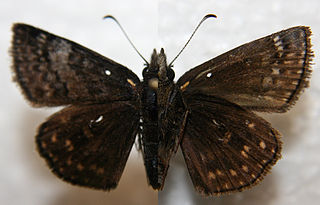
Erynnis brizo, the sleepy duskywing or banded oak duskywing, is a species of Hesperiidae butterfly that occurs throughout North America and is commonly confused with E. juvenalis and E. lucilius. The species is listed as threatened in Connecticut and Maine.

Erynnis persius, commonly known as Persius duskywing, is a species of butterfly in the family Hesperiidae that occurs in North America. The eastern subspecies Erynnis persius persius is rarer and protected by law in some regions.

Calpodes is a genus of skipper butterflies in the family Hesperiidae.

Grais is a genus of skipper butterflies in the family Hesperiidae. It is monotypic, with the only species, Grais stigmaticus, commonly known as the hermit skipper, found from the south-western US (Texas) to Argentina, and Jamaica in the Caribbean
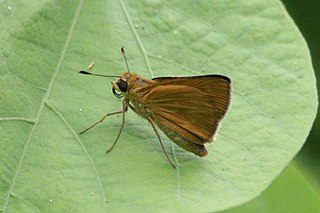
Nastra is a genus of skipper butterflies in the family Hesperiidae.
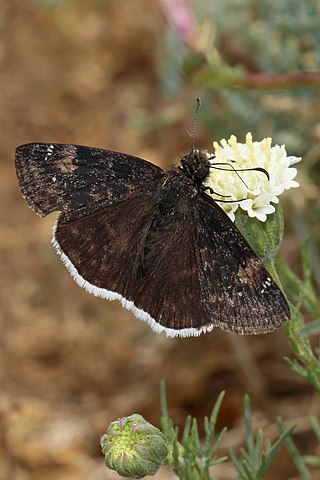
The Erynnini are a tribe in the skipper butterfly subfamily Pyrginae. They are a moderately diverse but quite plesiomorphic and inconspicuous group, and except for the Holarctic species of the type genus Erynnis occur only in the Neotropics.
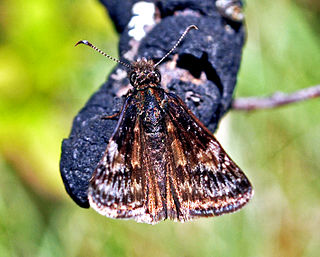
Erynnis lucilius, the columbine duskywing, is a species of butterfly in the family Hesperiidae. It is found in North America from southern Quebec to Manitoba and south to the north-eastern United States. It is part of the skipper family because its wings create a skipping pattern.

Erynnis pacuvius, also known as Pacuvius duskywing, Dyar's duskywing or buckthorn dusky wing, is a species of skipper butterfly in the family Hesperiidae. It is found in southern British Columbia and in most of the western United States.

The Erionotini are a tribe of skipper butterflies in the subfamily Hesperiinae.

Ephyriades arcas, the Caribbean duskywing, is a butterfly of the family Hesperiidae. It is found in Central America and the Caribbean, the type specimen being described from Saint Kitts.
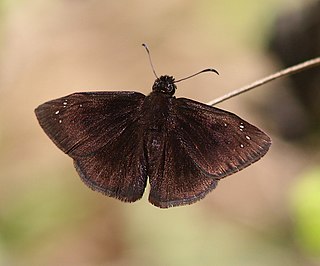
Ephyriades brunnea, the Florida duskywing skipper, is a butterfly in the family Hesperiidae. It was first described by Gottlieb August Wilhelm Herrich-Schäffer in 1865. The larvae feed on Barbados cherry, while wild coffee has been noted as an important adult nectar source, along with Bidens alba, Croton granduosus, and Lantana involucrata. The larvae are known to be parasitized by two species of parasitic wasp. It is found in South Florida, inhabiting pine rockland habitats. The species is of conservation concern.
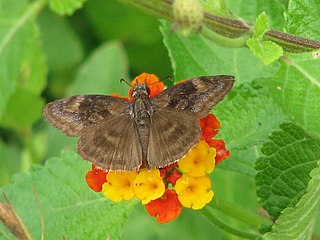
Gesta invisus, the false duskywing, is a species of spread-wing skipper in the family Hesperiidae. It was described by Arthur Gardiner Butler and Herbert Druce in 1872 and is found in Central and North America.

Erynnis telemachus, the Rocky Mountain duskywing, is a species of spread-wing skipper in the butterfly family Hesperiidae. It is found in North America.
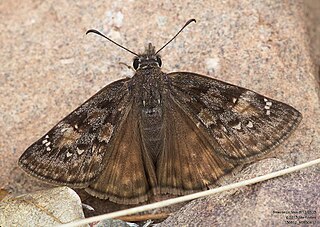
Erynnis meridianus, the meridian duskywing, is a species of spread-wing skipper in the butterfly family Hesperiidae. It is found in Central America and North America.

Erynnis tristis, commonly known as the mournful duskywing, is a species of spread-wing skipper in the butterfly family Hesperiidae. It is found in Central America, North America, and South America. It is mottled brown with a white fringe on the hind wings. It appears similar to the funereal duskywing, but the mournful duskywing is more likely to appear in urban areas. The larva feeds on young oaks while adults nectar from a variety of wild and garden flowers.

Burnsius is a genus of New World checkered-skippers in the butterfly family Hesperiidae. The genus was erected by Nick V. Grishin in 2019.



















